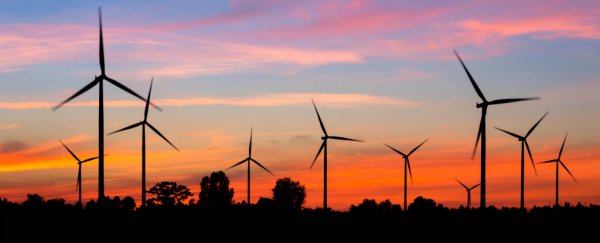The US could cut greenhouse gas emissions from electricity production by an incredible 78 percent below 1990 levels within just 15 years - AND keep up with growing energy demand in the process, a new study from the US National Oceanic and Atmospheric Administration (NOAA) reveals.
The research shows that, if it wanted to, the US could be getting most of its electricity from existing solar and wind technology by 2030, at hardly any extra cost to consumers. All it'll take is the construction of 'electron superhighways' to transmit electricity across the country. In other words, what the hell are we waiting for?
"Our research shows a transition to a reliable, low-carbon, electrical generation and transmission system can be accomplished with commercially available technology and within 15 years," said Alexander MacDonald, one of the lead authors of the report, which has been published in Nature Climate Change.
The study used a mathematical model to evaluate the future energy demands across the US, as well as future cost, energy-generation, and transmission scenarios. The results revealed that, based on technology that already exists, it would be totally feasible for wind and solar to power the majority of the country – the only thing we need to improve is how we move that electricity around the country.
Right now, even though solar and wind energy is getting cheaper than ever before, the problem is that the energy sources aren't constant, so the US has continued to invest in back-up plans, which generally involve burning natural gas or other emission-belching fossil fuels.
But the new report suggests that by simply being a little smarter about how electricity is transmitted across the country, these back-up plans would no longer be necessary, or at the very least, the need for them would be greatly reduced.
The results are based on the idea that, somewhere in the US, the sun is always shining or the wind is always blowing enough to meet the rest of the country's energy needs. All we need to do is find a way to move that electricity efficiently.
The key to this is better energy transmission, and the study authors have called for construction of an "electron superhighway", or – to be more technical – a high-voltage direct-current transmission grid (HVDC).
"With an 'interstate for electrons', renewable energy could be delivered anywhere in the country while emissions plummet," said MacDonald. "An HVDC grid would create a national electricity market in which all types of generation, including low-carbon sources, compete on a cost basis. The surprise was how dominant wind and solar could be."
The researchers also took things one step further, and mapped out the best places for solar panels and wind farms to be constructed in order to feed into this electron highway. The red areas below show the best spots to build wind turbines (left) and solar panels (right):
 Chris Clack/University of Colorado Boulder
Chris Clack/University of Colorado Boulder
The study found that, even if the price of renewable energy doesn't decrease as predicted, the US could still cut its CO2 emissions by 33 percent below 1990 levels by 2030, and could deliver electricity at 8.6 cents per kilowatt hours - cheaper than the 9.4 cents per kilowatt hour Americans paid in 2012.
Given the best case scenario, which would result in the 78 percent emissions cuts, the price of electricity would only increase to 10 cents per kilowatt hour.
"The model relentlessly seeks the lowest-cost energy, whatever constraints are applied," said one of the researchers, Chris Clack, from the University of Colorado Boulder. "And it always installs more renewable energy on the grid than exists today."
Even better, by making these changes to the electric sector, the US would successfully cut its greenhouse gas emissions by a greater amount than it pledged at the Paris climate summit last year, without having to make any other changes.
"This study pushes the envelope," said Mark Jacobson from Stanford University, who wasn't involved in the study, in an accompanying editorial in Nature Climate Change. "It shows that intermittent renewables plus transmission can eliminate most fossil-fuel electricity while matching power demand at lower cost than a fossil fuel-based grid - even before storage is considered."
